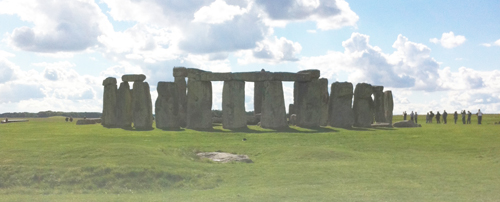You may not be able to trace your forebears to Neolithic times, but Stonehenge is at last worth visiting again, writes Andrew Chapman.
 Everyone’s been to Stonehenge already, haven’t they? Even if you haven’t, you may be aware of the halcyon days of the early 1970s when it was still possible to meander among the stones themselves or, more likely, the eyesore of more modern times with high security fences, a prefab toilet block and a general feeling that this World Heritage site deserved better treatment. One TripAdvisor reviewer in 2006 pretty much summed it up: “I’ve never met anyone who was not disappointed by Stonehenge.” With more than a million visitors a year (two thirds from overseas), that was of great concern.
Everyone’s been to Stonehenge already, haven’t they? Even if you haven’t, you may be aware of the halcyon days of the early 1970s when it was still possible to meander among the stones themselves or, more likely, the eyesore of more modern times with high security fences, a prefab toilet block and a general feeling that this World Heritage site deserved better treatment. One TripAdvisor reviewer in 2006 pretty much summed it up: “I’ve never met anyone who was not disappointed by Stonehenge.” With more than a million visitors a year (two thirds from overseas), that was of great concern.
But now everything has changed, and if you’ve avoided this extraordinary piece of ancient heritage, it’s time to reconsider. Thanks to a lavish £27m scheme to rethink how visiting Stonehenge should work, a brand new visitor centre opened in December 2013, safely one and a half miles away from the stones themselves. It met with mixed feelings to begin with, while the newly landscaped visitor centre and transport links were bedding in, but several years on, it feels like a great success.
Gone, for one thing, is the old A344 to Shrewton, which forced the monument itself into a corner between that and the A303, forever jammed with caravans heading for Cornwall. Re-routing the A344 was actually first proposed in 1927 – but now, at last, it has been done, and all that’s left of the old leg by Stonehenge is a greened-over track which now looks like an ancient rural byway. The A303 remains as it was, clogged with slow drivers rubber-necking at the monument – there are hopes to add more lanes, though what that would mean for the astonishing archaeological density of this area is unclear.
Now, one arrives via a new roundabout on the A303 to a vast (and still growing) car park, mercifully out of sight of Stonehenge itself. The visitor centre is unashamedly modern, and its ‘Marmite’ architecture probably means you’ll love it or hate it – but either way, its sleek, low-slung curves feel an improvement. Inside is the inevitable gift shop, offering a vast array of model trilithons and the like, and the exhibition.
The latter offers a truly 21st century take on what we understand of the monument’s history, focused around an impressive circular screen showing the monument through its history, and the changing seasons.
Also here are around 250 prehistoric objects, including a Neolithic skeleton, with informative labels – what a Victorian curator would have crammed into a single room has here been given an echoing modern space.
Outside, meanwhile, five Neolithic-style houses have been built to show how the monument’s builders may have lived. These are particularly well done, and add more of a human element to the visitor centre, which can feel a little cold in atmosphere.
But what really stands out is the new setting for the monument itself. From the centre, one can either walk the 1.5 mile route along the former A344, or take a shuttle bus – these stop a respectful distance from the stones themselves. One still can’t go right up and hug them, but one can stand surprisingly close, and it’s even possible, if you choose your moment, to snap them without a coachload of visitors in the view. The sweep of the landscape, featuring the Heel Stone, Avenue and Cursus, now feels much more open.
September 2015 saw the centenary of Stonehenge passing into the hands of Sir Cecil Chubb, a local barrister, asylum operator and racehorse breeder – he bought it at auction for £6600. It is thanks to him that the monument passed into public hands (in 1918). For the first time in perhaps 40 years, it feels that his legacy and the landscape alike have been honoured.
